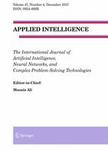版权所有:内蒙古大学图书馆 技术提供:维普资讯• 智图
内蒙古自治区呼和浩特市赛罕区大学西街235号 邮编: 010021

作者机构:Nanjing Univ Posts & Telecommun Sch Comp Sci Nanjing 210023 Peoples R China NanJing Pharmaceut Co Ltd Digital Innovat Dept Nanjing 210012 Peoples R China Nanjing Univ Posts & Telecommun Sch Automat Nanjing 210023 Peoples R China Nanjing Univ Posts & Telecommun Sch Internet Things Nanjing 210003 Peoples R China Nanjing Univ Posts & Telecommun Jiangsu Engn Res Ctr HPC & Intelligent Proc Nanjing 210003 Peoples R China Wuhan Univ Sch Comp Sci Wuhan 430072 Peoples R China
出 版 物:《APPLIED INTELLIGENCE》 (Appl Intell)
年 卷 期:2025年第55卷第6期
页 面:1-20页
核心收录:
学科分类:08[工学] 0812[工学-计算机科学与技术(可授工学、理学学位)]
基 金:Natural Science Research Start-up Foundation of Recruiting Talents of Nanjing University of Posts and Telecommunications [NY222015] China Postdoctoral Science Foundation [2024M761486]
主 题:Software defect prediction Product metrics Process metrics Multi-view learning Deep learning
摘 要:Software defect prediction plays a crucial role as a quality assurance technology in software development. The software metrics are associated with the software quality and are vital for prediction models. Most existing defect prediction methods build the prediction model ignoring the complementary information between these two kinds of metrics. In this work, we intend to jointly leverage these two kinds of metrics. For a software instance, we regard the product metrics and the process metrics as its two views. We model the problem of discriminative feature learning from these two kinds of metrics as the problem of multi-view learning. However, it is a challenging task to construct an effective prediction model based on both product and process metrics due to the heterogeneity in data of product and process metrics, and the defect data often has class imbalance characteristic. How to explore the discriminant both inter-view and intra-view effectively has not been well studied. These characteristics make it challenging to construct an effective prediction model. In this paper, we propose a Deep Multi-view Defect Prediction (DMDP) approach, which can predict software defect based on both product and process metrics. We design a neural network with two sub-network branches, which are enforced to share the weights in the last output layer, to map the data from different views to a common space. To guide the training of networks, we design the loss function including the discrepancy loss, discrimination loss and classification loss, which further promotes the distribution consistency across views, makes full use of label information to obtain the discriminative representations, and utilizes the complementarity information for prediction. To alleviate the class imbalance problem, we design a dynamic sampling strategy for dealing with class-imbalanced data. Comprehensive experiments are conducted on 15 projects from three widely used defect datasets. The experimental resul